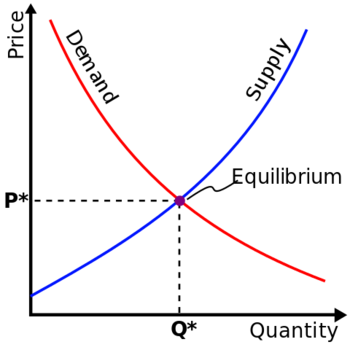Market

A market is where buyers and sellers exchange goods and services. This market can be physical or virtual and is usually defined by the whatever is exchanged;[2] for example petroleum is exchanged on the oil market. Usually, markets are good for society because these transactions allow people to get the goods and services that they want. These goods and services are exchanged for currency, information, or just other goods and services. Anything that someone values can be exchanged in a market, but today usually a buyer is paying money for a seller else to provide something. The way that buyers and sellers interact in the market determines the how much will be provided (the supply) and how badly these goods and services are wanted (the demand). The interaction between supply and demand of the goods and services will determine the market value (the price) and quality amount that will be sold.
Types of Markets
There are two main types of markets today and when referring to the whole market of a country, one can refer to it as the economy, meaning the general position of the government towards their economy. The two main types are mixed economies and market economies. In addition there are centrally planned economies in which the government has total control, although there are very few if any of these economies today. Canada's economy is a mixed economy.
A Note on Markets
There are many types of markets, they can big or small, local or global, general or specific, legal or illegal and of a number of other variations. For example, with in the commodity market there is an oil market where oil is bought and sold around the world through a computer network, this is an example of a digital or electronic market. In contrast, a gas station is an example of a physical market where hard goods are traded, one puts gasoline in their vehicle and trades currency to buy the gasoline at a determined price.
A Few Examples of Specific Markets:
- Oil Markets
- Commodity Markets
- Financial Markets
- Currency Markets
- Media Markets
Market Failure
Click here for the main article
When a market fails to function properly, that is, it does not have a pareto efficient equilibrium; the market is said to be failing. This is due to a number of possibilities such as externalities, imperfect competition, misallocation of public goods and other factors.[3] This occurs because there is a net external social cost which is in opposition to the idea that markets are efficient when all transactions benefit society in a positive way.[4] For more information, see market failure. When the inefficiencies in a market become so great that supply cannot meet demand or it cannot correct for an externality to a sufficient level then the market has ceased to function properly.
See Also
References
- ↑ Wikimedia Commons. (May 14, 20156). Market Curves [Online]. Available: https://commons.wikimedia.org/wiki/File:Supply-demand-equilibrium.svg
- ↑ D. Rutherford. ‘’Routlege Dictionary of Economics’’. London: Routlege, 1995, pp. 286.
- ↑ J.Black, N. Hashimzade, and G. Myles. (2009) ‘’A Dictionary of Economics’’, 3rd ed. [Online], Available: http://www.oxfordreference.com.ezproxy.lib.ucalgary.ca/view/10.1093/acref/9780199237043.001.0001/acref-9780199237043-e-1219?rskey=1ao9sr&result=1 [14 May 2016]
- ↑ A. Goolsbee, S. Levitt and C. Syverson. ‘’Microeconomics’’. New York: Worth Publishers, 2013, pp. 644.

